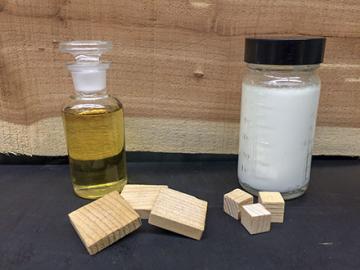Cedar’s Hidden Potential

A bottle of cedarwood oil (left) and white cedarwood oil emulsion (right) to treat pine blocks for termite and fungal assays. (Fred Eller, D4215-1)
Trained as an entomologist, Agricultural Research Service (ARS) chemist Fred Eller still has a soft place in his heart for insect-related research. When he noticed ants climbing up the pole of his backyard hummingbird feeder to steal sugar water from birds, he didn’t like it.
“I had read that ants didn’t cross cedar mulch, so I put a string around the bottom of the pole and covered it with cedarwood oil,” he says. “For two years, I didn’t have any ants going up that pole. Then, the piece of string rotted and fell off, and the ants came back.”
Eller, who works at ARS’s National Center for Agricultural Utilization Research in Peoria, Illinois, theorized that cedarwood oil would also repel or kill other types of insects. Collaborating with other ARS scientists, he tested the oil against houseflies, ticks, and mosquitoes. “It killed them all. It was also repellent against economic pests such as the little fire ant in Hawaii and the red imported fire ant,” he says. These studies were published in Environmental Entomology in 2014 and in Hawaiian Entomological Society Proceedings in 2015.
Both a Prize and a Pest
The reddish heartwood of Eastern red cedar, which is native to 37 states, is highly prized for making chests, closet liners, fenceposts, and other products. However, this cedar tree, Juniperus virginiana, is considered an invasive species because of its encroachment onto U.S. pastures and rangeland. It is also a host for cedar-apple rust and must be removed near apple orchards to prevent the disease.
It’s been said that there are more red cedars now than there were in the late 1400s, because the natural, periodic wildfires that once burned them back are being suppressed. “In addition, birds eat the tree’s berries and transport them everywhere,” Eller says.
One Wood Preserves Another
Eller is looking for ways to extract more value from the abundant supply of this coniferous evergreen. For example, cedarwood oil, which is worth about $13 a pound, can be extracted from small trees and made into a natural wood preservative that deters termites and wood-decay fungi. “That would benefit farmers and provide a natural wood treatment for consumers,” Eller says.
To find out if cedar’s protective compounds could be used to treat other types of wood, Eller experimented with pine. He extracted chemicals from cedar trees, treated pine wood with the chemicals, and found that the pine was resistant to termite and fungal attacks.
In more recent research, published in International Biodeterioration and Biodegradation in 2018, he went a step further by mixing cedarwood oil and modified starch to make a milky-white emulsion. Pine treated with the emulsion was resistant to attack by termites and several species of wood-rot fungi. The mixture also inhibited water absorption.
“We’re not sure if the termites didn’t like the taste and starved to death of if they ate the mixture and it killed them,” he says. “We haven’t teased that out yet.”
Cedarwood oil has a lot of potential as a natural pest-control agent and wood treatment, he adds. “A long-term goal is to be able to get rid of some of these invasive trees, provide a few dollars for farmers who sell them, and have a natural product for consumers—whether it’s used as a repellent or wood treatment.”—By Sandra Avant, ARS Office of Communications.

